The incidents narrated ahead are based on the experience of 2nd Lieutenant Baljit Singh, 3rd Madras Infantry Battalion, 69th Infantry Brigade, who had participated in the legendary 1965 Indo-Pak war. The contents are a pen picture of the Indian counter offense in the Pakistani Punjab sector, which includes ‘Attack on Maharjke’, ‘Battle of Phillora’ and ‘Siege on Sialkot’.
Counter Strike
On 6th September 1965 everyone was prepared for the action which was to be carried out in response to the Pakistani foul play, Operation Gibraltar. The plan of action had been laid out. Troops were being gathered at Sambha, which was the new ‘Harbor Point’, before distributing their area of operation.
In the evening I was informed by my company commander, Captain Oberoi that our first objective is a town named ‘Maharjke’ just few kilometers away from the international border. While he was briefing me, so that I could pass the same to the fighting force of the company, it was learnt that ‘Pakistani Air Observation Post’ (AOP) had become aware of our movement. We realized this at that point of time when the Pakistani Air force bombarded our base camp. Although not much damage could be done by them but it was sufficient indication for us to maintain our ‘Stealth’.
Lieutenant General Harbaksh Singh: “There should be only one thing in the consciousness of every single person whether an officer or soldier that he should have no mercy on these invaders who have invaded our motherland!”
The next morning we packed up our ruck-sacks, inspected our weapons and were once again all set for the last briefing by our senior officials of the battalion. Lieutenant Colonel B.K. Bhattacharya let every single chap know what Lieutenant General Harbaksh Singh, commander of North Western Sector told to each and every division’s commander who was about to give everything it had to safe guard the freedom of Indian citizens. He said that “There should be only one thing in the consciousness of every single person whether an officer or soldier that he should have no mercy on these invaders who have invaded our motherland!” Listening these words added more fuel to the anger which was boiling hard in every person, who was out there and the Pakistani bombardment which had taken place last night, simply multiplied the effect.
Such kind of leadership qualities were one of the prime factors that proved exceptionally effective in India’s favor and turned the tide on Pakistan.
Attack on Maharjke
On the night of 7th September, the whole of 69th Infantry Brigade moved closer to the international border for capturing Maharjke. The formation of this brigade was:
3rd Madras infantry battalion was to encircle the town from right side while the remaining brigade from left. I along with Captain Oberoi was facing the fore front leading Alpha Company along with Bravo Company. At 12 o’clock night we crossed the international border and moved towards Maharjke. Barely had we reached 2 to 3 kilometers inside Pakistan, artillery shelling started and all of us ducked down. Although the topography consisted of farms but the intensity of shelling was very high, we could not move any further for some period of time till our artillery started to give a befitting reply. Pakistanis had the advantage of long range guns, thanks to the American assistance they received, which could fire from a distance of over 20 kilometers, whereas we had the world war-2, 25 Pounder (88mm) guns whose range was somewhat less comparatively.
…these people who are arriving towards us are certainly not Indian troops since we were neither contacted nor informed in advance about any such activity.
Somehow, when the artilleries were engaged we got some time to buckle everyone up and shouting the war cry we moved ahead carrying little for death. But by this time the Pakistanis had spotted our movement from their machine gun posts because of the concentration of artillery fire. This prompted them to fire machine guns on us. We were still a kilometer away from the town but the plain ground was providing little assistance to us in front of the machine gun fire. Ignoring it we kept on motivating our troops to move. A kind of reverse psychology was taking place, the harder we were resisted and the stronger became our resolution to rout the Pakistanis. We literary crawled a distance of 200 yards in the face of enemy fire before we could spot their positions. In between we got the opportunity to crouch and move when the machine guns silenced for a very brief period. We would take the judgment from the flight of ‘tracer rounds’, fired from the guns, in order to remain safe and get closer.
When we reached a distance of 50 to 70 yards away from the machine gun posts, we saw that there were two guns being handled by the Pakistanis, which were firing in the diagonal manner forming an arrow head, anyone who got into the intersection of the guns would die there itself.
It was necessary to clear these machine guns posts in order to get into the town. At this point two kerelite Lance Naiks volunteered for the job of silencing the guns. I must say that those two men turned up at the right time and showed their guts. Slowly, taking the advantage of night and benefit of doubt, leaving the two companies behind, they crawled up to the gun posts and destroyed them by lobbing grenades. It was confirmed that the gun posts have been destroyed after we saw two explosions taking place.
All of us swiftly but cautiously moved closer to the damaged Pakistani first line of defense and after we confirmed that there was no danger of any enemy retaliation, we moved inside the town. Quickly both the companies moved through the town lobbing grenades in the houses and firing bullet shots, so that if there were any enemy soldiers hidden inside could be located and the chances of getting involved in an ambush could be avoided. After we had cleared the town and our remaining brigade had arrived as a back-up, we established defensive positions outside the town, facing towards Pakistan, on the main road that led into Maharjke.
…confirmed that they were Pakistani soldiers dressed in civilian clothes and were trying to disguise themselves in order to escape.
In the early morning hours of 8th September after we had secured the area, I heard noises of people walking from the town and arriving on the road where we were present. Due to unclear visibility because of darkness I could not confirm whether they were our soldiers or of enemy’s. I let Captain Oberoi know about the situation immediately. Thereafter I thought that these people who are arriving towards us are certainly not Indian troops since we were neither contacted nor informed in advance about any such activity. Captain Oberoi was also doubtful about these people since if they happened to be enemy soldiers and came to know about our formation, then they would try to inflict casualties by firing small arms on us or would call for artillery fire on the town, which would prove very devastating.
After a brief period we were able to see them, from their wardrobe we figured out that they were not from the Pakistani militia, since they looked like civilians and were accompanied by women and elderly looking persons. But the moment they reached 50 to 55 meters from us, I noticed that some of the men carried rifles in their hands and while walking with the group, were quite watchful. This confirmed that they were Pakistani soldiers dressed in civilian clothes and were trying to disguise themselves in order to escape. When they reached to an audible distance, I stood up from my position and stopped them. Watching this one of the armed men jumped from the group and tried to take firing position. I fired immediately, looking at his movement and shot him dead. In the mean time both the companies got alerted and encircled the group.
We found that there were 20 Pakistani armed personnel’s that were leading the civilians out of the town. The first thing we did was separation of civilians from Pakistani soldiers. Allowing the civilians to take a route to their safety, we arrested the Pakistani soldiers in order to send them at the brigade headquarters for their interrogation.
By then sun rise had taken place and we got the opportunity to check out for some more people hiding inside the town and also searched for certain information revealing things, which could prove beneficial for us.
During the detailed search carried out it was found that Maharjke was a Pakistani ‘Police Training Centre’ designed more or like a cantonment. Some of the things which we recovered from the place were logistic support vehicles (two battery operated, American origin jeeps) and personal belonging of soldiers ranging from garments, blankets, shoes and trunks.
For the whole of 8th and 9th September we did patrolling in the nearby villages surrounding Maharjke, for identification of Pakistani soldiers and locating their position. In some of the villages we identified considerable Pakistani militia concentrations, who were detailed to engage the inward moving Indian troops. In order to neutralize such villages, we used the tactics to block the exit route of the village and called for mortar fire, so that the shelling of area would cause the enemy concentration to break up and flee away before they could think of something else.
Likewise approximately 300 Pakistani villages were destroyed by the entire 6th mountain division put forward on the front of Sialkot sector. The entire ‘Sakargarh’ district was overrun by the 69th Infantry Brigade, in which Maharjke was situated and 20 to 30 villages were secured in addition.
The artillery shelling done in response of Pakistani howitzer fire proved quite effective.
On 10th September we had achieved a firm control over our first objective, so the senior officials of the brigade were occupied in further planning of the much needed things with their ‘Army Supply Core’ counterparts as we had made a vital break through enemy lines and were not in a mood to retreat under any circumstances. While the people from medical core were engaged in treating the wounded soldiers we found that most of the casualties that we received were mainly due to the shelling which had taken place, when we were inching our way towards Maharjke through unprotected farms and because of the machine gun fire. I found out that my batman, who was crawling just next to me, was killed by one of the bullet shots fired from those guns. But he was not the only one who faced abrupt death, there were many more like him who died before we were able to silence those guns.
The artillery shelling done in response of Pakistani howitzer fire proved quite effective. Since the fear of a brigade size attack was more than enough to make the entire town vacant, well before we reached at its gates. In the late evening when I was on patrolling duty we heard an echoing sound of armored columns approaching Maharjke. I thought that these must be the Pakistani tanks since they were coming from deep inside Pakistan. Nor had we been informed about any such tank movement by our commanders neither we knew about any Indian armored formation closer to us. Keeping an eye on the movement of those armored vehicles I contacted Captain Oberoi who in turn contacted Lieutenant Colonel Bhattacharya and reported the matter to him. When he learnt about the fact he too was astonished and quickly contacted his superiors. It was only then we came to know that these tanks belonged to the Indian Armored Corps and were returning from ‘Phillora’.
Such was then the tensed atmosphere in war, which at times becomes more or less chaotic. While a person is in the battle ground he has to depend more on his senses than anything else because at last it is the soldier himself who has to take vital decisions keeping in mind a lot many things including the responsibility of life of men, under his command.
As expected our next target was now to capture Phillora. The brigade commander in accordance with the three battalion commanders had laid down the immediate plan of action and the same night we started our travel towards Phillora.
When the tank columns reached closer, I along with my patrol party went ahead and interrupted them. Learning the fact that we were Indian soldiers, from one of the tanks a Sikh commander came out and let us know what had happened in Phillora. He told that Pakistanis used ‘Blitzkrieg’ tactics to counter our armored regiments.
Blitzkrieg was an effective tactics used in world war-2 by the Germans for routing the opponent forces in which a combination of air attack, armored support and artillery cover is provided, resulting in a strong blow. This tactics can be countered only when the strength of infantry is quite large. The Indian top brass however depended on the much older ideology of wave attacks, in which wave after wave of either infantry or armored regiments would be thrown on the enemy. The big disadvantage of this way of fighting is that there is a possibility of lack of proper co-ordination and heavy casualty.
After we escorted those armored columns to the brigade headquarter we came to know about one more news which was a bad one. In the link-up with our brigade they informed that in the early hours of war the armored regiments were pushed in to halt the Pakistani advance, well before the mountain divisions had arrived on the Punjab front. At Phillora the Pakistanis, owing to air support destroyed an entire column of fourteen tanks, including that of column’s commander.
As expected our next target was now to capture Phillora. The brigade commander in accordance with the three battalion commanders had laid down the immediate plan of action and the same night we started our travel towards Phillora.
Battle of Phillora
As we started for Phillora, we were accompanied by a tank regiment, consisting mostly of Sherman and Stuart tanks, to provide armored support. All of us got mounted on the tanks and began to mentally prepare for another but much awaited encounter with the enemy. Phillora was approximately 10 kilometers away from Maharjke. Since our battalion had already seen action before, so most of the people were keeping a calm state of mind which was much needed at that moment.
Many of the soldiers though appeared to be relaxed but somewhere in the back of their mind had an unfulfilled desire of giving the Pakistanis their piece of mind.
On 11th September, in the early day hours we reached outskirts of Phillora. But perhaps the Pakistani Air Observation Post (AOP) had identified our movement and we were attacked with several rounds of artillery fire. The moment the fire started we jumped from the tanks and quickly took defensive positions nearby. The tanks had to be camouflaged in the fields to prevent them from getting pin-pointed by the Pakistani Air Observation Post.
After few hours, when the shelling stopped I along with 2nd Lieutenant Dalal were send by our respective company commanders for forward patrolling in the enemy area for identification of their location, manual and material strength. Slowly we creped inside the town with our columns from different sides only to find out that it had been already vacated. Probably the initial attack made by the Indian armored regiments was fierce enough to make Pakistanis run away.
We came across many name plates outside the houses which indicated that Phillora was the home of many Pakistani army personals. After the town was cleared by us we established a few more defensive positions just outside the town, facing Pakistan so that any counter attack made by the Pakistani militia could be handled appropriately.
Many of the soldiers though appeared to be relaxed but somewhere in the back of their mind had an unfulfilled desire of giving the Pakistanis their piece of mind. For consoling such enthusiastic lads of mother India, we carried out aggressive patrolling in the villages surrounding Phillora, since from our experience at Maharjke we had become aware of the Pakistani tactics of guerilla warfare. The Pakistani militia was abandoning big towns like Phillora and took refuge in the close by villages for re-grouping themselves.
We adopted the usual method of clearing such areas. A group of soldiers would attract the enemy fire from one side, all the exit routes were blocked and two teams consisting of 3 to 4 soldiers would lit up the village from behind the enemy or mortar fire was called upon.
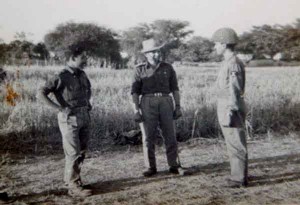
2nd Lieutenant Jacob, 2nd Lieutenant Baljit Singh along with a fellow officer in a sugar cane field near Phillora
On one such occasion I led a column of soldiers to neutralize a village, which was reported to be containing Pakistani militia. The location of that village was such that it was not much easy to get a clear idea of the enemy hide out. In order to get a better view of the things I climbed up a tree which was over-looking the village. The moment I reached a sufficient height, from which the whole village could be seen, a salvo of bullets were fired at the tree. Although I had taken a risk but it did not go in vain. I was able to locate the enemy hide out and by the fire power, which they had advertised, an idea of their strength was obtained. Guiding the soldiers to block the exit routes I called for retaliatory mortar fire and within no time the enemy concentration had been neutralized.
But as it happens on most occasions that for achieving a goal you have to give something. Like Maharjke in Phillora too we had casualties in the form of loss of life. After reaching Phillora we had secured the area around the town. But this fact in addition of being known to our superior officials was also known to Pakistanis, who taking advantage of the concentration of troops use to rain artillery fire on the town, aiming at us. In one such fire which took place in the morning hours killed Major Chaudhary, the commander of Bravo Company. He had just come out of his position for having a view of the things when Pakistani artillery fire started and one of the shells exploded just next to him, cutting him down. Later to fill the void created due to his death, Major Nerula joined as commanding officer of Bravo Company in the midst of the war.
This was just an example of the ‘anything possible’ situation, which prevails throughout the war.
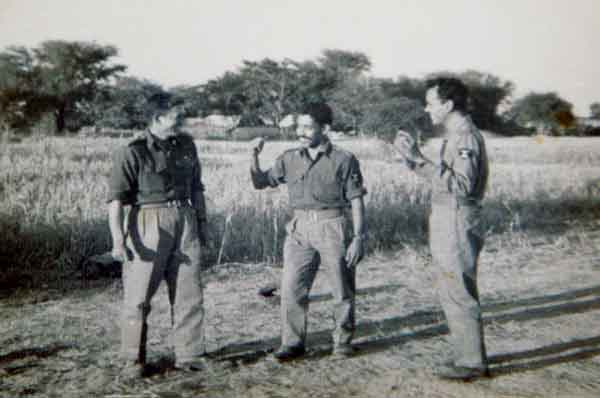
2nd Lieutenant Baljit Singh, 2nd Lieutenant Jacob and 2nd Lieutenant Srinivas plan out the action in a village near Sialkot
There were two more instances when we escaped narrowly. On one of the occasions of clearing up the Pakistani militia concentration in the surrounding villages, I formed up a team of one JCO and five riflemen including one NCO for clearing a nearby village. The soldiers who by now had neutralized many such re-grouping camps were aware of the tactics to be used. Though the JCO seemed to be somewhat nervous but they assured me of carrying out the task with success. But somehow when they reached near the village they were unable to maintain the secrecy of their presence and invited enemy fire upon themselves in which the NCO was injured. When they fell back to the base camp only then we came to know what went wrong. The nervous JCO was unable to hold on his nerves and committed a mistake. He was immediately released from his duty and was sent back to the headquarter.
This was the second incident of the kind in which the soldiers were not able to hold their nerves.
Probably this happened since there was no officer in-charge of the team or perhaps the JCO and neither the soldiers under him were having the required confidence upon themselves to take ‘on the spot decisions’. One more factor which was indirectly responsible for this tragedy was the system to be followed. Since I and 2nd Lieutenant Dalal were mostly given the tasks of patrolling and clearing enemy concentration areas, as a result no other officer was able to get the opportunity of knowing about the things to be taken care off in such operations. Though we shared inputs and experiences with other officers of the Companies but there still remains a difference between listening and performing.
Since I had undertaken patrolling duties continuously for frequent number of times and 2nd Lieutenant Dalal was deployed elsewhere, so there was no other officer available to accompany that fateful team. Moreover the order had been passed on from the battalion headquarter to Alpha Company, of which I was the second-in-command and for engaging officers from other companies needed the consent of respective company commanders, which at that time was although possible but the response could be predicted well before, from the kind of attitude of the Company commander. This system was indeed an evil during war days which still persists till date. As a result looking at the situation and after consulting with my Company commander, Captain Oberoi, I had no other option left. But the JCO had to be made the team leader and coincidently had earlier taken part in such clearing operations. Probably the habit of working under guidance or the assumed burden of responsibility and his over-consciousness might have made him to lose his nerve.
The incident of loosing ones nerve is not very rare. On the contrary it is more or less very common. It can happen with any one, not necessarily it happens with lower cadre soldiers but it does happen with officers. One such incident happened when I, 2nd Lieutenant Jacob, 2nd Lieutenant Srinivas, 2nd Lieutenant Bhadesra and 2nd Lieutenant Malik were given the task of securing a particular stretch of railway line which connected Sialkot with Lahore. We went at the location which was informed to us with a group of 20 soldiers. We established defensive positions on both sides of the railway track. As per the information that we had received, Pakistanis used this rail route for reinforcing their small pockets which had been broken after Indian advance.
On 28th September 1965 the news of declaration of ceasefire reached us. For many of the soldiers and officers it was out of the blue.
By the time we had secured the area it was late evening. There was no sign of any Pakistani movement but our source of information was coincident enough about the data that was passed on to us. We had to wait for some more time when finally we heard the sound made by the boots of soldiers while walking along the railway track. Since we had been over there for quite a long duration and the visibility had diminished due to the darkness, so it took some more time for us to roughly get an idea of the numerical strength of the enemy. We held on to our rifles and had taken firing positions. The plot was perfect for ambushing Pakistanis but the only fact which could turn everything was the number of men on each side. We totaled 25 men, five officers and twenty riflemen. In order to over-power the enemy our strength should have been higher than what enemy had. At that moment this thought perhaps ran down the minds of most of us. I was mentally prepared to take on the enemy, since the intensive patrolling done while clearing villages had given me a lot of expertise in handling Pakistanis. But our group also consisted of few nervous chaps and a fresher. None of the 2nd Lieutenants with me at that moment had participated in any such task before.
On the other hand the soldiers allotted to each officer were four. Hence any hastily taken decision could prove fatal if went wrong. After sometime when the Pakistanis approached a distance of 100 to 150 meters, we identified them and were just trying to get an approximate idea of their strength when one of the 2nd Lieutenants opened fire, without letting any one of us know and along with him his four soldiers too fired, which alerted the enemy. Within no time the entire scene got changed. Opening of fire before Pakistanis came close enough to be surprised, revealed our positions to them. The atmosphere suddenly became confusing. Now the Pakistanis started firing on us and the situation was going out of control.
Since I was leading the group it was my responsibility to tackle the things. In utter chaos many of the men and few of my fellow officers fell back. Now we were left depleted in strength, totaling 5 to 6 men. The advantage we had at that moment was the idea of location, we knew the area around us but the Pakistanis being cut-off from that area had little knowledge of the changes around them.
I quickly dispersed my men to project a larger coverage area. I send three men to my right side and other two to the left, who were manning an LMG (Light Machine Gun). Like this we projected a frontal coverage area of 18 to 20 meters and opened a full force counter fire. It worked and we saw the Pakistanis retreating back. We continued to fire till the Pakistanis were out of sight along with their show-off. This was the second incident of the kind in which the soldiers were not able to hold their nerves. But this time they were accompanied by the officers who were leading them. Had the Pakistanis been more in numbers and called for an artillery fire all the remaining of us would have been killed. But it is said that when a person has removed the fear of death or even the fear itself from his mind, then there is no scope of any kind of fear in his life.
Siege on Sialkot
After almost 10 days of stay in the area around Phillora and securing several vital enemy installations, we came to know that the 26th Division which had been stationed at Jammu, had positioned themselves in such a way that a siege could be laid on Sialkot. But for 69th brigade it appeared as if the war was over, since we hadn’t received any further orders except of carrying out long patrols and consolidating our positions.
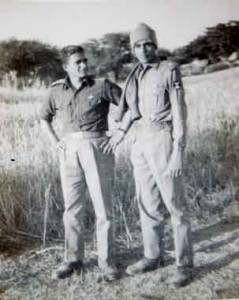
2nd Lieutenant Baljit Singh and 2nd Lieutenant Srinivas (after ceasefire) on the outskirts of Sialkot
On one occasion I had undertaken a patrolling duty to identify any enemy movement in a specified village that lay closer to Sialkot. With a five men team including myself travelled close to the given location. Upon reaching there we found that a Gorkha battalion was deployed facing Sialkot, for blocking any enemy movement in or out of the town. After talking to them we learnt that the entire town had been vacated by the Pakistanis fearing a three sided Indian attack.
In order to mark the presence to Indian troops around Sialkot and as a memory of 1965, I along with my mean pulled out a milestone, from the main road that led into Sialkot, which embarked in Urdu stating “Sialkot 1 Mile”. I feel proud to say that the milestone which was brought by me from Sialkot still remains, as a prized memento of Indian Army’s success in the 1965 operation, in the battalion headquarter of 3rd Madras battalion.
On 28th September 1965 the news of declaration of ceasefire reached us. For many of the soldiers and officers it was out of the blue. Also at that time there was civilian outrage against the ceasefire.
Continued: 1965 War: True Story of 2/Lt Baljit Singh-III
By presenting articles, through www.indiandefencereview.com, related to the operations carried out by the Indian Army, on the western front during 1965 war, I intend not to question anybody’s contribution who had participated in that war. But I wish to tell to our upcoming generations about the significance of this war, which was termed as the “War of Young Officers” as well as ‘The bloodiest war fought by the Indian army ever’, not only owing to the high number of casualties inflicted on the part of the enemy but due to the quality of leadership shown by young recruits irrespective of the kind of commission which was offered to them. – Colonel Baljit Singh.




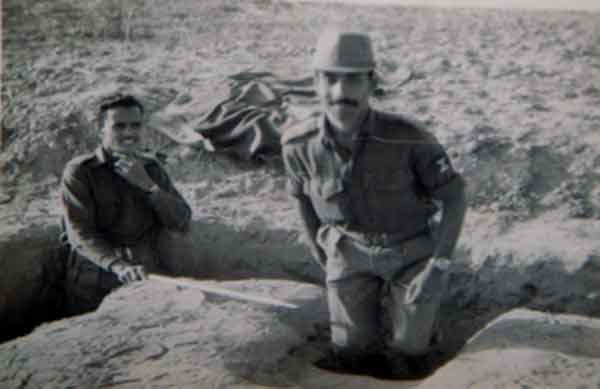
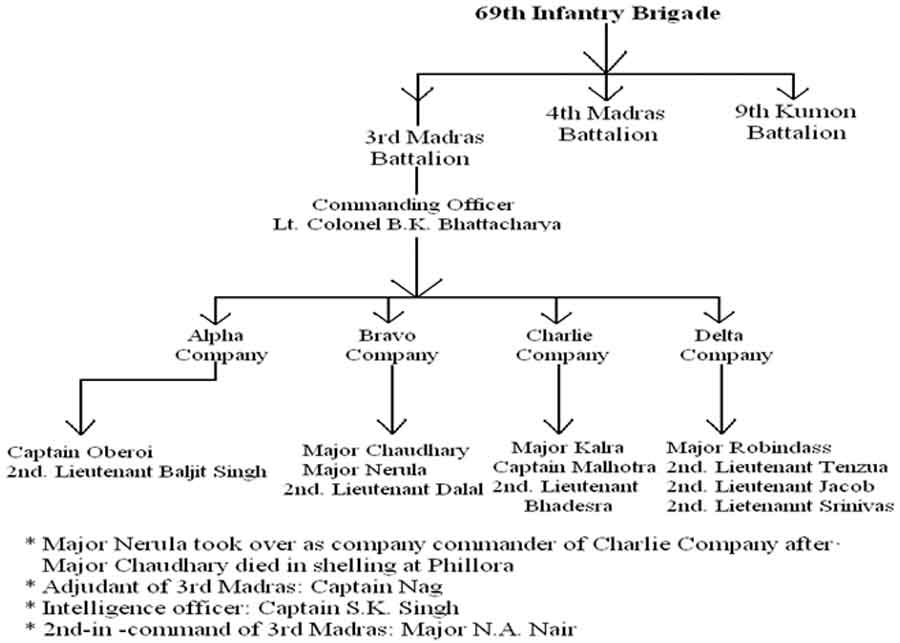
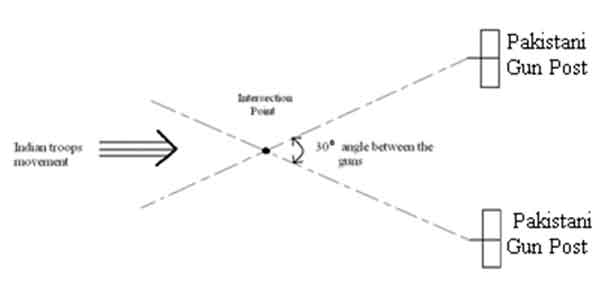
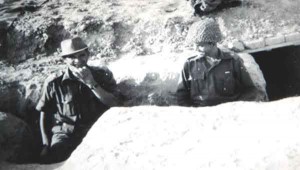
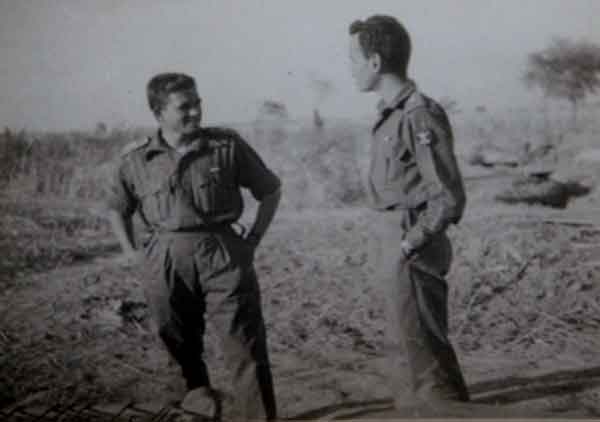

Nice realistic and true story